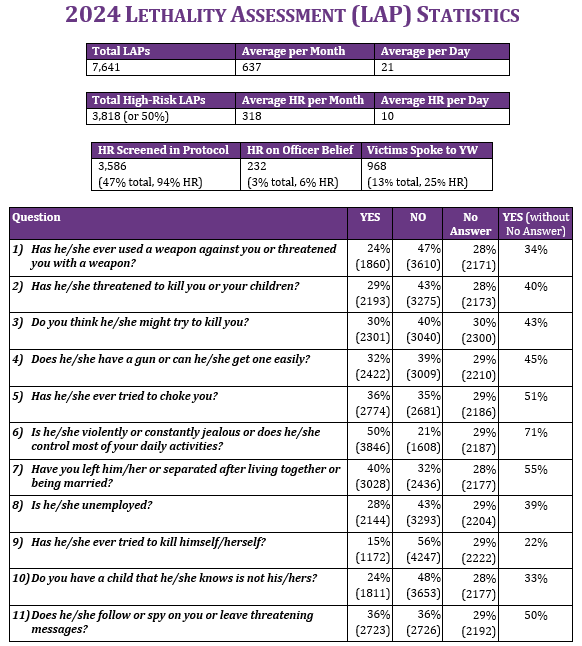Lethality Assessment Program (LAP)
In December 2016, the OFS, Metro Nashville Police Department (MNPD), and the YWCA Nashville Middle Tennessee launched the Lethality Assessment Program or LAP. The LAP is an 11 question assessment that MNPD officers administer to anyone who has experienced intimate partner violence to determine their level of risk. If a victim screens in as “high risk,” the officer immediately connects them with the YWCA’s hotline to plan for their safety. OFS manages the LAP data and multi-disciplinary team intervention plans for the highest risk cases.
Statistics:
In 2024, MNPD administered 7,641 LAPs and the YWCA’s hotline answered close to 1,000 LAP calls.

Metro Nashville Police Department (MNPD) administers the LAP screen on every intimate partner violence case they responded to, even when a crime doesn’t occur but power dynamics or previous domestic violence history makes it necessary. Consistently, the top 3 “yes” answers on the LAP for individuals that answer the questions are:
- Strangulation: 51% of victims reported being strangled by their abuser.
- Leaving the relationship: 55% reported they previously tried to end the relationship.
- Jealousy and control: 71% reported that their abuser was violently/constantly jealous or controlled their daily activities
What is the Lethality Assessment Program (LAP)?
- The LAP is a lethality screen for intimate partner violence victims recognized by the U.S. Department of Justice as a “promising practice” in intimate partner homicide prevention.
- The LAP is an evidenced-based tool developed from Dr. Jacqueline Campbell’s extensive research on lethality indicators preceding domestic violence homicide.
- Agencies and programs in at least 30 states are implementing the LAP.
How Effective is the LAP?
- In one study of the LAP’s effectiveness, they found that victims who received the screen were:
- Almost 2 times more likely to receive immediate services and obtain medical care.
- 2.5 times more likely to remove or hide their abuser’s weapons.
- 1.5 times more likely to engage in protective actions.[1]
How does the LAP work in Nashville-Davidson County?
- If the victim screens in as “high risk,” MNPD calls the YWCA’s 24-hour hotline.
- The victim may or may not choose to speak with the domestic violence hotline advocate.
- If the victim does not choose to speak with the hotline advocate, the officer makes a plan with the advocate on how the victim can stay safe.
- If the victim chooses to speak with the hotline advocate, the individual makes a plan with the advocate on how they can stay safe.
- The victim may give permission for the hotline to follow up in 24 hours about additional needs.
- The hotline advocate can directly refer the victim on the initial LAP call or follow-up call to the Office of Family Safety’s Centers (FSC & JCAC) or the Domestic Violence Division Counseling Unit.
How Does the LAP Help Victims?
- Traditionally, police departments must focus their time on the specific domestic violence incident they are responding to, not prior incidents or potential future incidents.
- The LAP allows officers to learn about prior, potentially lethal incidents and gives them an evidence-based tool to evaluate the victim’s future danger.
- The LAP gives officers common language to express concern about a victim’s situation and to encourage them to access resources.
- Evidence-based concern from law enforcement and a hotline advocate can provide the victim with a different perspective on their situation, making them more likely to engage in services.
- The LAP also provides a “direct connect” with a service provider on-scene. Prior to LAP implementation, police protocol was to provide the victim with a resource brochure.
Learn more about the LAP from the Maryland Network Against Domestic Violence: https://lethalityassessmentprogram.org/
For more information about the LAP in Nashville, please contact our team at OFSHighRiskTeams@jis.nashville.org.
[1] Messing, Jill Theresa, Jacquelyn Campbell, Daniel W. Webster, Sheryll Brown, Beverly Patchell, and Janet Sullivan Wilson. “The Oklahoma Lethality Assessment Study: A Quasi-Experimental Evaluation of the Lethality Assessment Program.” Social Service Review 89.3 (2015): 499-530. Web.


